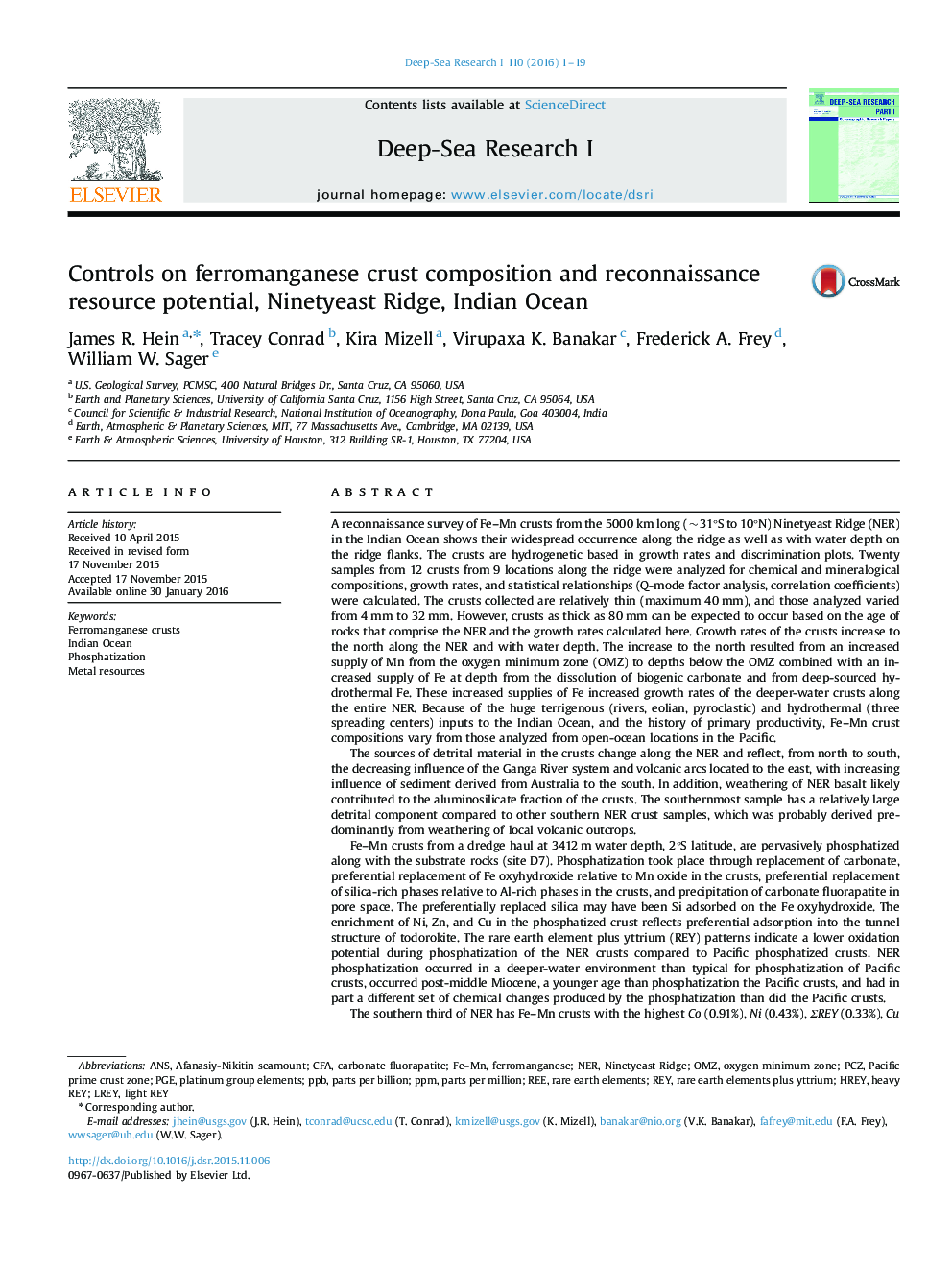| کد مقاله | کد نشریه | سال انتشار | مقاله انگلیسی | نسخه تمام متن |
|---|---|---|---|---|
| 4534451 | 1626320 | 2016 | 19 صفحه PDF | دانلود رایگان |
• Reconnaissance survey of Fe–Mn crusts from Ninetyeast Ridge (NER) in Indian Ocean.
• Chemical and mineralogical compositions and growth rates change with latitude.
• Unique crust compositions compared with highly prospective areas in the Pacific.
• Phosphatization occurred in deeper water and at a younger age than Pacific crusts.
• High metal concentrations warrant exploration for southern sector of the NER.
A reconnaissance survey of Fe–Mn crusts from the 5000 km long (~31°S to 10°N) Ninetyeast Ridge (NER) in the Indian Ocean shows their widespread occurrence along the ridge as well as with water depth on the ridge flanks. The crusts are hydrogenetic based in growth rates and discrimination plots. Twenty samples from 12 crusts from 9 locations along the ridge were analyzed for chemical and mineralogical compositions, growth rates, and statistical relationships (Q-mode factor analysis, correlation coefficients) were calculated. The crusts collected are relatively thin (maximum 40 mm), and those analyzed varied from 4 mm to 32 mm. However, crusts as thick as 80 mm can be expected to occur based on the age of rocks that comprise the NER and the growth rates calculated here. Growth rates of the crusts increase to the north along the NER and with water depth. The increase to the north resulted from an increased supply of Mn from the oxygen minimum zone (OMZ) to depths below the OMZ combined with an increased supply of Fe at depth from the dissolution of biogenic carbonate and from deep-sourced hydrothermal Fe. These increased supplies of Fe increased growth rates of the deeper-water crusts along the entire NER. Because of the huge terrigenous (rivers, eolian, pyroclastic) and hydrothermal (three spreading centers) inputs to the Indian Ocean, and the history of primary productivity, Fe–Mn crust compositions vary from those analyzed from open-ocean locations in the Pacific.The sources of detrital material in the crusts change along the NER and reflect, from north to south, the decreasing influence of the Ganga River system and volcanic arcs located to the east, with increasing influence of sediment derived from Australia to the south. In addition, weathering of NER basalt likely contributed to the aluminosilicate fraction of the crusts. The southernmost sample has a relatively large detrital component compared to other southern NER crust samples, which was probably derived predominantly from weathering of local volcanic outcrops.Fe–Mn crusts from a dredge haul at 3412 m water depth, 2°S latitude, are pervasively phosphatized along with the substrate rocks (site D7). Phosphatization took place through replacement of carbonate, preferential replacement of Fe oxyhydroxide relative to Mn oxide in the crusts, preferential replacement of silica-rich phases relative to Al-rich phases in the crusts, and precipitation of carbonate fluorapatite in pore space. The preferentially replaced silica may have been Si adsorbed on the Fe oxyhydroxide. The enrichment of Ni, Zn, and Cu in the phosphatized crust reflects preferential adsorption into the tunnel structure of todorokite. The rare earth element plus yttrium (REY) patterns indicate a lower oxidation potential during phosphatization of the NER crusts compared to Pacific phosphatized crusts. NER phosphatization occurred in a deeper-water environment than typical for phosphatization of Pacific crusts, occurred post-middle Miocene, a younger age than phosphatization the Pacific crusts, and had in part a different set of chemical changes produced by the phosphatization than did the Pacific crusts.The southern third of NER has Fe–Mn crusts with the highest Co (0.91%), Ni (0.43%), ΣREY (0.33%), Cu (0.22%), Te (146 ppm), Pt (1.5 ppm), Ru (52 ppb), and Rh (99 ppb) contents. These are among the highest Pt, Ru, and Rh concentrations measured in marine Fe–Mn deposits. Because of these high metal concentrations, exploration is warranted for the southern sector of the NER, especially at shallower-water sites where the platinum group elements (PGE) and Co are likely to be even more enriched.
Journal: Deep Sea Research Part I: Oceanographic Research Papers - Volume 110, April 2016, Pages 1–19
